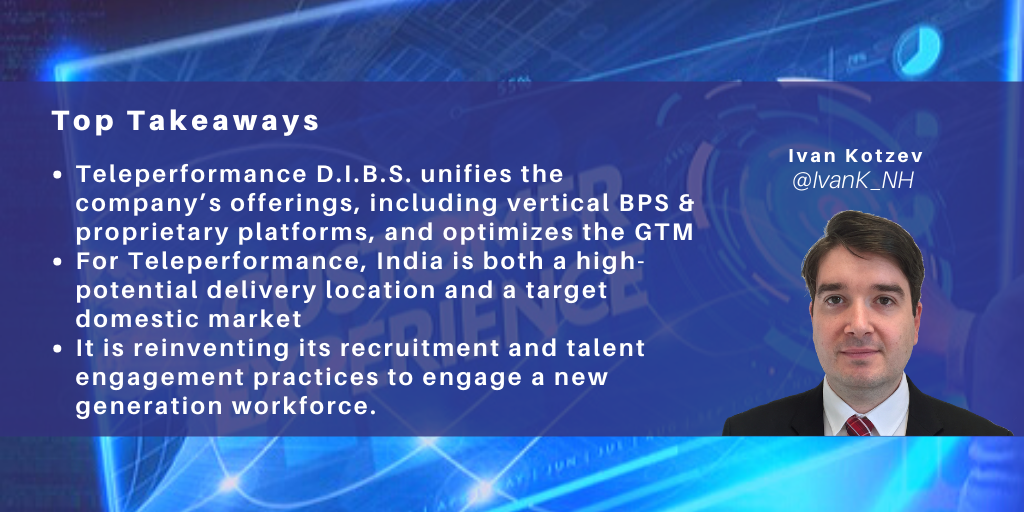Search posts by keywords:
Filter posts by author:
Related Reports
Related NEAT Reports
Other blog posts
posted on Feb 14, 2020 by Ivan Kotzev

At the end of January 2020, NelsonHall attended Teleperformance’s global analyst meeting in Mumbai. Here are some insights into the company’s progress since the Intelenet acquisition in October 2018 and the formation of Teleperformance Digital Integrated Business Services (D.I.B.S.).
Repositioning as a knowledge partner
Teleperformance’s reorganization in 2019 to form Teleperformance D.I.B.S. was a step towards unifying the company’s offerings, placing the ~100 proprietary platforms under one umbrella, and optimizing the go-to-market approach. D.I.B.S. includes the company’s vertical specific business process management services, analytics, intelligent automation, and digital transformation capabilities, which also covers the recently launched Innovation and Experience Center in Santa Clara.
D.I.B.S. has a dedicated technology, analytics, and process excellence practice (T.A.P.) with its own P&L. It serves as an internal catalyst (and educator) for the entire organization regarding transformation. The knowledge practice currently has ~600 experts including data scientists, developers, Lean Six Sigma Black Belts, COPC practitioners, and CX consultants. While Teleperformance aims to scale the team to ~1k people by the end of 2020, the ultimate goal is to democratize and embed the ‘transformational DNA’ across the company. As a first step, T.A.P. is identifying projects in key markets; for example, partnering with sales staff in Colombia and France. It also organizes internal webinars and training sessions on topics such as RPA and analytics. The objective is to upskill employees across the organization to identify value addition opportunities and to know the basics of which processes to target for automation and analytics deployment. Further, T.A.P. looks to find potential synergies in integrated business services, starting with the operations in India.
An example opportunity is in integrated business services with the company’s Finance & Accounting practice. Teleperformance has ~90 F&A clients supported by ~10k employees in 12 countries. Over the last two years, the work has gradually shifted towards more complex work and contextual tasks such as financial planning and analysis (FP&A), tax, treasury and other niche areas under record to report (R2R). As a result, it offers aggregated packages of products, including intelligent automation with their micro tools strategy, analytics, and F&A talent who bring global and local accounting standard experience and knowledge.
India’s booming CX services market
For Teleperformance, India is both a high-potential delivery location and a target domestic market. For example, a large proportion of the T.A.P. resources are in India. At the moment, the company has ~80k people in the country, with approximately half supporting the domestic market. It continues to scale, with capacity expansions in 2019 focused on Tier 2 and 3 Indian cities. Teleperformance plans to further add new locations mainly in Tier 2 cities for international email and chat work. High-growth verticals include BFSI, healthcare, and travel.
In a recent interview, Teleperformance CEO Daniel Julien placed a big bet on India, predicting that the workforce in the country will increase to ~150k people in the next few years.
Engaging a new generation workforce
Teleperformance’s market vision for ‘High Tech, High Touch’ relies on remaining a people-centered business where the company recruits, trains, coaches, and manages a global workforce. With more generation Y and Z cohorts dominating the labor pool, Teleperformance is reinventing its recruitment and talent engagement practices. The company employs psychometric assessment-based hiring to identify dark personality traits, particularly with a view to preventing intentional security breaches. In recruitment, it also evaluates the emotional intelligence of applicants and actively involves social media as a channel, a practice widely adopted in India.
In training, the focus is on self-learning games, comics, video learning, and delineation of career paths. While the traditional agent learning curve is disappearing because of self-service and bots, the company is shifting to bite-size learning and gamification using video, leaderboards, props-based learning, VR/AR, e-learning platforms, simulations, and exploration games.
Another approach to attract and retain talent is work-at-home-agent (WAHA) to complement on-site delivery. Teleperformance is increasing its WAHA population and has ~10k FTEs globally, with only 60% in the U.S. In India, it plans pilots in 2020 out of two major cities for chat and email customer care for international and domestic clients; for example, in retail. These plans are dependent on regulatory approval. As a next phase, it will include voice services as well.
The Fourth Industrial Revolution already impacting CX services
Most of Teleperformance’s ~850 clients are facing significant disruption from digitally native competitors, new technology such as cloud and IoT, and shifting customer profiles and preferences. The new economy clients have a different set of requirements, prioritizing scalability and multinational delivery to meet high growth patterns; for example, social media and e-commerce platforms looking for content moderation services. In this environment, Teleperformance looks to offer an in-depth understanding of the client industry and provide horizontal technology, processes, and people across the customer journey. Part of these investments include setting up the CEO office of ‘Transformation’ headed by Bhupender Singh, partnerships with process mining firms, doubling down on its internal cybersecurity expertise, expanding the T.A.P. practice, and a potential M&A to add more digital and/or consulting capabilities.
